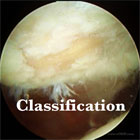|


|
synonyms:anterior knee pain, patellofemoral pain,
Patellofemoral Pain ICD-10
Patellofemoral Pain ICD-9
- 719.46(pain in joint, lower leg)
- 717.7 (Chondromalacia patella)
Patellofemoral Pain Etiology / Epidemiology / Natural History
- Muscle imbalance is commonly the cause in children and adolescents. May be related to inflexibility secondary to growth spurt, patellar hypermobility, improper training, change in footwear. (Smith AD, ICL 2003;52:691).
- Risk Factors: shortened quadriceps muscle, abnormal VMO response time, decreased explosive strength, hypermobile patella. (Witvrouw E, AJSM 2000;28:480).
Patellofemoral Pain Anatomy
- Articular cartilage of the patella is up to 5mm thick; the thickest in the body.
Patellofemoral Pain Clinical Evaluation
- Be aware of secondary gain=workers compensation/litigation
- Point to pain location
- Pain dull/sharp: constant/intermittent; night pain, crepitation/swelling; instability; positional; pain with squatting; pain with ROM; other joint pain; gout; inflammatory arthritis; rashes; other aches and pains; affects on sports/work; litigation/compensation
- Consider Minnesota Multiphasic Personality Inventory
- Generally complain of pain with stair climbing or prolonged sitting.
- Observe attitue, anxiety level, facial expressions, interactions
- Ambulation, standing varus/valgus, deep need bend patellar tracking
- Note any scars
- Quad tightness-flex knees as far as possible with pt prone, pelvis stable. Normal-symmetric flexion c heals at or near buttocks.
- Patellar tilt testing demonstrates decreased lateral patellar elevation.
- Assess patellar tracking in trochlea c pt supine through ROM; crepitation/pain
- Note point in flexion arc where pain occurs, may indicate location of articular lesion
- Palpate quads; iliotibial band; lateral retinaculum; patellar tendon; medial/lateral infrapatellar tendon; medial retinaculum, vastus medialis
- Q-Angle: angle formed by the intersection of a line drawn from the ASIS and the patella and one from the tibial tubercle to the patella. Normal <10° in men, <15° in females.
- Patellar Apprehension: patella is pushed lateral with the knee in 20-30° of flexion. A feeling of impending dislocation (apprehension) is a positive test (indicates patellar instability).
- Pain reproduced with compression of the patella while flexing and extending the knee.
- J-sign: lateral deviation of the patella in terminal extension = patellar instability.
- Generalized ligamentions laxity(thumb, elbows)
- Assess andkle and subtalar aligment. Foot pronation can affect patellar alignment.
Patellofemoral Pain Xray / Diagnositc Tests
- Weight-Bearing A/P, and Lateral; eval for bipartate patella. Trochlear dysplasia indicated when the depth of the trochlea intersects the anterior cortex on the lateral view.
- Merchant axial view=knee flexed 45 degrees, beam projected 30 degrees caudad from the plane of the femur. Centrial ridge of patella should lie at or medial to the bisector of the trochlear angle. Evaluate patellar tilt.. Not very sensitive
- Lateral view evaluate patella alta, patella baja.(patellar tendon length should be <1.2 times the height of the patella
- CT axial images demonstrate lateral patellar tilt. Images should be taken at 15°, 30°, and 45°. Patella is significantly tilted if the patellar tilt angle (angle created by lines drawn along the lateral facet of the patella and the posterior femoral condyles) is less the 12° on the 15° flexed images.
Patellofemoral Pain Classification / Treatment
- Patellofemoral brace / McConnell taping, PT with extensor mechanism and hamstring stretching and strengthening, NSAIDs, terminal knee extensions from 20° to full extension. (Witvrouw E, AJSM 2000;28:687).
- Lateral Release.
- Tibial Tubercle Transfer:
Patellofemoral Pain Associated Injuries / Differential Diagnosis
Lateral Release Complications
- Hemarthrosis 7.2% (Small NC, Arthroscopy 1988;3:215)
- Medial subluxation of the patella. (Hughston JC, AJSM 1988;16:383)
Patellofemoral Pain Follow-up Care
Patellofemoral Pain Review References
- Post WR, JAAOS 2005;13:534
|


